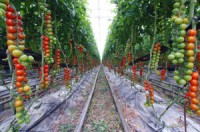Tomatoes Greenhouse Production
go.ncsu.edu/readext?384578
en Español / em Português
El inglés es el idioma de control de esta página. En la medida en que haya algún conflicto entre la traducción al inglés y la traducción, el inglés prevalece.
Al hacer clic en el enlace de traducción se activa un servicio de traducción gratuito para convertir la página al español. Al igual que con cualquier traducción por Internet, la conversión no es sensible al contexto y puede que no traduzca el texto en su significado original. NC State Extension no garantiza la exactitud del texto traducido. Por favor, tenga en cuenta que algunas aplicaciones y/o servicios pueden no funcionar como se espera cuando se traducen.
Português
Inglês é o idioma de controle desta página. Na medida que haja algum conflito entre o texto original em Inglês e a tradução, o Inglês prevalece.
Ao clicar no link de tradução, um serviço gratuito de tradução será ativado para converter a página para o Português. Como em qualquer tradução pela internet, a conversão não é sensivel ao contexto e pode não ocorrer a tradução para o significado orginal. O serviço de Extensão da Carolina do Norte (NC State Extension) não garante a exatidão do texto traduzido. Por favor, observe que algumas funções ou serviços podem não funcionar como esperado após a tradução.
English
English is the controlling language of this page. To the extent there is any conflict between the English text and the translation, English controls.
Clicking on the translation link activates a free translation service to convert the page to Spanish. As with any Internet translation, the conversion is not context-sensitive and may not translate the text to its original meaning. NC State Extension does not guarantee the accuracy of the translated text. Please note that some applications and/or services may not function as expected when translated.
Collapse ▲Note the “Tomato Grafting” resource near the bottom of this page.

Rows of tomatoes grown hydroponically in a greenhouse. Greenhouse tomatoes have experienced a surge in popularity in recent years. NOTE the “Tomato Grafting” resource near the bottom of this page.
A Cost Assessment of Growing Greenhouse Tomatoes in N.C.
This 2007 study surveyed several North Carolina greenhouse tomato growers to determine their actual costs for start-up and production. Costs vary depending on initial availability of resources and production practices. This report takes a closer look at the costs that will likely vary the most.
U.S. Greenhouse/Hothouse Hydroponic Tomato Timeline
This timeline has been created to give a general overview of crop production, worker activities and key pests in greenhouse/hothouse hydroponic tomatoes in the United States.
Greenhouse Tomato Handbook (Spanish version)
If you are preparing to invest time and money into growing greenhouse tomatoes, you should be fully aware of the pitfalls as well as the benefits before proceeding. You can be successful if you follow the basic guidelines in this Mississippi State University handbook and other publications.
Greenhouse Tomatoes
This Mississippi State University site includes an extensive FAQs section as well as links to additional greenhouse tomato publications that could be valuable to North Carolina growers.
Growing Hydroponic Tomatoes
This interactive Web site of the University of Arizona provides practical, accurate information on growing hydroponic tomatoes for students, hobbyists and beginning growers.
Interactive Tomato Model for a Hydroponic System
This Ohio State University site is intended to help hydroponic vegetable growers decide how to adjust important growing parameters to allow for the production of high quality tomatoes.
TOMATO GRAFTING
Webinar: Grafting for Disease Management in Organic Tomato Production
Watch this recorded webinar to learn about tomato grafting and how it can be utilized to manage diseases in organic open-field and high tunnel systems. Frank Louws of NC State University and Cary Rivard of Kansas State University provide information regarding rootstock selection as well as the grafting procedure itself in this presentation.
Vegetable Grafting Manual
Grafting of vegetable seedlings is a unique horticultural technology used worldwide to overcome soil-borne diseases and pests, and/or to increase plant vigor under various environmental stress conditions such as salinity, drought, flooding and low temperature. A comprehensive manual on grafting vegetables has been developed collaboratively by research scientists at various institutions working to explore this technology.
Vegetable Grafting Information
This site from the University of Arizona offers comprehensive grafting resources, including “How to Graft” pages for tomato tube grafting, cucurbit hole insertion grafting and cucurbit single cotyledon grafting methods. Grafting benefits and background are outlined. You can also find grafting tool/equipment suppliers, propagators and seed suppliers.
Reviewed 7/1/2022


